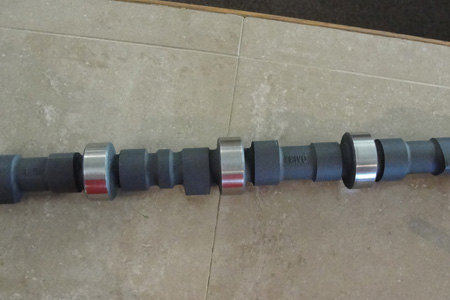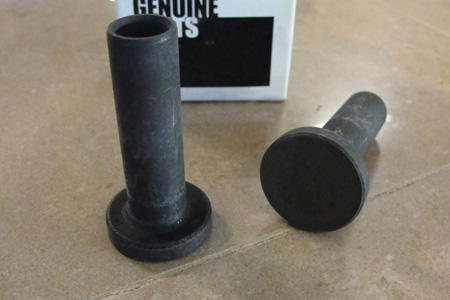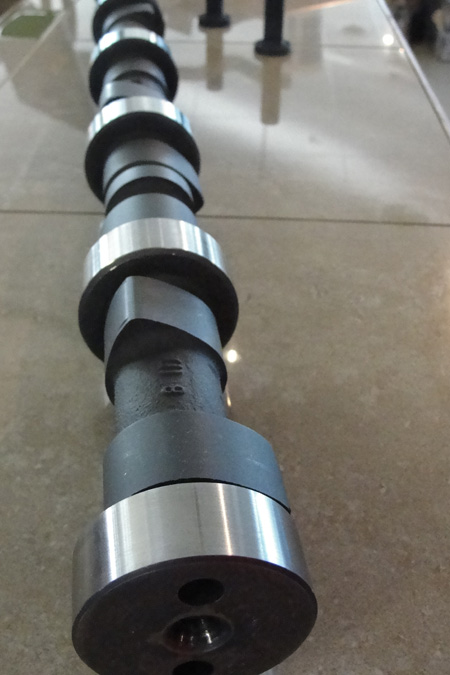Diesel performance is nothing new. What is new is the level of interest in diesels for all kinds of racing; everything from traditional truck and tractor pulling to drag racing, even sports car and endurance racing.
Diesel engines are a different type of animal when compared to gasoline engines. While both use the same four-stroke cycle of combustion, diesels use the heat of compression rather than a spark to ignite the air/fuel mixture. A diesel engine requires a much higher static compression ratio than a gasoline engine, and on most engines there is no intake vacuum because the engine is unthrottled. Speed and power outputs are determined by the fuel injection system.
Most diesel engines are also turbocharged, yet make most of their torque and power at relatively low rpm (typically 2,500 to 4,000 rpm, though in some forms of racing diesels are being revved to 5,000 to 7,000 rpm).
So what does this mean to our readers? It means if a customer asks you to build a performance diesel engine, it’s going to take a different approach than building a performance gasoline engine. The bottom end in most diesel engines is fairly stout already, with forged steel crankshafts and beefy connecting rods, so the amount of modifications that may be needed here are usually minimal. And because most street performance and pulling applications don’t require a lot of rpms, engine balance is not as critical as in a high revving gasoline engine.
Pistons may have to be cut, modified or replaced, however, depending on how much turbo boost the engine will be running, what kind of fuel it will be burning (diesel only, or diesel plus nitrous oxide or alcohol), and what kind of modifications are being made to the camshaft and valvetrain, which is the focus of this article.
Breathing Considerations
Because diesels require a lot of compression, camshaft duration tends to be short with minimal overlap. Valve lift may also be limited by the tight piston-to-valve clearances in most diesel engines. So unlike gasoline engines, you can’t go hog wild with lift and duration to make more power. A bigger camshaft can provide more power, but only if the lift and duration are right for the turbochager, cylinder heads, pistons, valvetrain and application.
The most significant power gains in a diesel engine come from increasing the amount of boost delivered by the turbocharger(s). But there’s more to the secret than just bolting on a bigger turbo. The camshaft must have the right exhaust characteristics so it will spool up the turbo faster and keep it spinning at peak efficiency in the engine’s power band. For some types of pulling, the power band can be quite narrow, say only 2,000 to 3,000 rpm for a big agricultural diesel engine, or maybe 3,000 to 5,000 rpm for a pickup truck. A street truck, by comparison, may make most of its power from 1,800 to 3,200 rpm.
If engine speed drops too low during a truck or tractor pulling event, the turbo can stall or “chirp,” causing the boost pressure to suddenly drop. This kills power and may even cause the engine to stall.
“Less is more” is often the best advice when choosing a diesel performance cam, especially if the engine is going to be in a street vehicle. “The vehicle owner may think he wants a lot more power, but a camshaft that delivers a broader power band will have much better throttle response and everyday driveability on the street,” explains Guy Tripp of SoCal Diesel in Valencia, CA.
“The application determines the grind as far as we are concerned,” Tripp says. “We develop our own camshaft specifications and use an outside vendor to grind our cores. We specialize in street and racing cams for Duramax diesels only. We always talk with our customers to find out exactly what they want to accomplish and what kind of turbo, boost pressure and other modifications are being made to their engine so the cam grind we provide is the best one for their application. Is it a street/towing application? Will they be sled pulling or drag racing? These are important things to know when choosing a cam.”
Lenny Reed of Dynomite Diesel Performance in Monroe, WA, says one of the secrets to getting more power out of a diesel is to pay more attention to the pressure developed in the cylinders. “I tried 18 different cam profiles for a drag racing diesel engine I was building, and none of them gave me the results I wanted. With gasoline engines, you want to increase valve duration to get more power,” Reed, a Cummins engine specialist, says. “But this approach just wasn’t working in the diesel engine I was building. Then I tried the opposite approach and started decreasing duration. It worked and I started seeing more power than I had before.”
Reed drag races a 950 horsepower pickup truck with a diesel engine and says his truck runs in the mid-10s in the quarter mile and consistently beats trucks that have more powerful engines. His secret? He makes better use of the power his engine produces because it has a broader power curve. By keeping the power level where it is, he has also improved reliability. “When you go over 1,000 hp in a diesel pickup truck, you start breaking driveline components,” he says.
Reed says that for street driven daily drivers, you want a camshaft that delivers a lot of cylinder pressure – which means limiting valve overlap. “You want adequate separation in valve timing, but you also have to keep the lobe separation tight so you don’t run into clearance problems. You don’t really need a lot of valve lift at low rpm on the street. Increasing lift often requires cutting piston reliefs or changing pistons,” he explains.
“The camshaft is probably the last five percent of the power equation, but a very important five percent,” Reed continues. “You also need the right injector timing, pump tuning and turbo sizing. When everything else is dialed in correctly, changing the camshaft provides the icing on the cake. But if you choose the wrong cam, it can really make things worse. A cam that has been optimized for sled pulling at 5,000 to 6,000 rpm would not be the right choice for a street driven truck.”
Reed says engine builders should also realize that they get what they pay for when they buy a performance camshaft. “If you’re paying $90 for a cam, you’re probably buying junk,” he cautions. However, even some high dollar billet steel cams may not be so great if the quality of the steel is not up to specifications.
One tip Reed offered for Cummins engines is that the press fit cam gears used up to 2003 have a tendency to push off the end of the camshaft if the engine is modified to produce upwards of 650 horsepower. For modified Cummins engines, he recommends converting to a bolt-on drive gear set.
Chuck Vogel of Vogel Manufacturing Company in Effingham, IL, says his company does diesel performance cams for a wide range of applications, including even the small one cylinder diesel engines that are found on some lawn & garden tractors. “Probably half of the people who are pulling or racing with B Series Cummins diesel engines are using our camshafts. So we have a lot of experience developing performance cams for diesels.”
Vogel says most diesels don’t require a lot of camshaft duration, and that different profiles for the intake and exhaust lobes deliver the best performance. “One of the biggest changes we’ve seen in recent years is that improvements in turbocharger design are allowing us to use more camshaft (more duration). Turbos that were capable of producing 35 psi of boost five years ago have been replaced with turbos capable of making 60 psi of boost today. These kinds of changes mean you don’t have to rev the engine higher to make more power. All you need to do is optimize the boost delivered by the turbo with the right sized cam. A camshaft with asymmetrical profiles for the intake and exhaust valves will deliver a broader and fatter power band.”
Vogel says that for some stock classes, he’ll regrind stock cams to his own specifications. For other applications, his company custom grinds billet steel cores to create a camshaft.
Kevin Morrisey, of Dr. Performance in Weatherford, TX, is another drag racing diesel aficionado whose drag truck is powered by a Cummins diesel producing 1,200 to 1,600 hp at 5,800 rpm. The turbo produces about 70 pounds of boost, which is, admittedly, much less than some of his competitors run. But adding nitrous more than makes up the difference. The pistons have been flycut to reduce compression down to 13:1 so the engine can handle a bigger shot of nitrous. Morrisey says the engine burns 13 lbs. of nitrous in a single pass! The camshaft is billet steel and the engine block has been modified to accept roller camshaft bearings for improved durability.
“The performance cams we sell for street diesel applications are cast iron with 105 to 110 degree centerlines. Our race cams for Cummins engines are billet steel with 108 degree intake centerlines, and are available with cam bearing inserts,” Morrisey says.
Steve Lowe Sr. of LSM in Waterford, MI, says his company does custom billet steel performance cams for a wide variety of applications, including Dodge Cummins engines, GMC and Chevy Duramax engines and Ford Powerstroke engines. LSM also makes billet steel Cummins engine blocks for racing.
Lowe says a mild cam along with some injector and turbo tuning will produce the best power gains for a street truck without sacrificing everyday driveability. But for racing or pulling, he encourages builders to modify the heads, pistons and turbo as well as the camshaft to realize serious power gains. “The role of the camshaft is to enhance these other power modifications,” he says.
Valvetrain Considerations
Since most diesels run at relatively low rpms, modifications that are required for the valvetrain are often minimal. This means you don’t need monster springs and pushrods to prevent the valves from floating at high speed. On the other hand, there may be some concerns about the effects of turbo boost on the intake valves.
Many diesel engines run very high boost pressures, from 80 to as much as 200 psi on some really wild racing engines. So there’s a concern that really high boost levels may overcome the force exerted by the springs on the intake valves forcing the valves open. While some diesel performance experts say that for every 10 psi increase in boost, you should use springs that are at least 10 psi stiffer than the stock springs (closed seat pressure), others say this really isn’t necessary because when the piston is coming up on its compression stroke, the pressure developed inside the cylinder will hold the intake valves shut.
On Cummins engines, there is also a concern that overly stiff valve springs may increase wear in the cam bores. In Cummins engines, there are no cam bearing inserts – the camshaft journals run directly on the machined bores in the block. Because of this, extremely heavy valve spring pressure pushing the rocker arms, pushrods and lifters down against the camshaft may cause the bottom of the cam bores to wear out. As the cam settles lower and lower into the block, it upsets valve lift and timing, causing a significant loss of power. One way to prevent this in a performance Cummins engine with stiffer than stock valve springs is to machine out the cam bores in the block and install aftermarket bearing inserts.
Camshaft Lubrication Issues
Another concern with increasing valve spring pressure is camshaft lobe and lifter wear. Most diesel engines, with some exceptions such as Duramax and some late model Caterpillar and International engines, still use flat tappet camshafts with flat bottom valve lifters rather than roller lifters.
The reasons for this are both economical and practical. Since most stock diesel engines run at low rpm and have relatively mild valve springs, there is not a lot of pressure on the cam lobes. Consequently, less expensive flat bottom lifters are usually fine to use. But when a diesel engine is modified for performance (and stiffer valve springs are installed to allow higher engine speeds), the increased load may cause rapid cam lobe and lifter wear – unless a racing oil or crankcase additive that contains an adequate level of ZDDP (Zinc Dialkyl Dithio Phosphate) is used.
In recent years, ZDDP levels in motor oil have been sharply reduced to prolong the life of the catalytic converter. Historically, ZDDP has been added to oils in concentrations of around 0.15% for phosphorus and 0.18% for zinc. But when “SM” rated motor oils appeared in 2005, phosphorus levels were reduced to 0.08%, or roughly half that of the previous generation of motor oils. Later this year, new GF-5 oil standards will be introduced.
The same problem affects both gasoline and diesel engines that are still using flat tappet camshafts. The remedy is to coat the cam lobes with high pressure assembly lube, and to use a crankcase additive or racing oil that contains adequate levels of ZDDP. Or, convert the valvetrain from flat tappet to a roller cam and lifters (if available).















